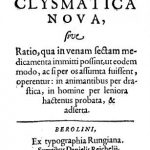Elsholtz JS. Clysmatica nova, sive ratio, qua in venam sectam medicamenta immuti possint, ut eodem modo, ac si per os assumpta fuissent, operentus : in animantibus per drastica, in homine per leniora heotenus probata, & adserta, 1665.
Catalog Record: Elsholtz JS. Clysmatica nova, sive ratio, qua in venam sectam medicamenta immuti possint, ut eodem modo, ac si per os assumpta fuissent, operentus : in animantibus per drastica, in homine per leniora heotenus probata, & adserta, 1665.
Title: Clysmatica nova, sive ratio, qua in venam sectam medicamenta immuti possint, ut eodem modo, ac si per os assumpta fuissent, operentus : in animantibus per drastica, in homine per leniora heotenus probata, & adserta / Joannes Sigismund Elsholtz.
AccessKey: adjs
Author: Elsholtz, Johann Sigismund.
WLM Call Number: WB 356 E1710 1665 RB
Accession NO.: RB9214
Publisher: Berolini : Reichel, 1665.
Edition: 1st ed.
Physical Description: 16 p. ; 16 cm.
Language: lat
Subject: Blood Transfusion.
Subject: Injections, Intravenous.
Type of Trace: Short Title
Title: Clysmatica nova.
Abstract: Elsholtz reports experiments with intravenous injections on humans and animals. The work begins with a description of the anatomy known at that time, and followed with a report of experiments based upon William Harvey’s work on the circulation of blood. Elsholtz speculates that the intravenous introduction of a substance to the heart through circulation of the blood would have a therapeutic value. To prove his theory, he describes experiments with intravenous injections on human and animals. He refers to injection into the anus, ears, uterus, bladder and penis as the “old clysmatics,” but calls injection into the veins and arteries the “new clysmatics”. He suggests that cures of the brain might be possible by intravenous injection of narcotics. He approached human experiments cautiously but suggested that criminals might be used for more drastic studies.
General Notes: In clamshell.
General Notes: J. S. Elsholtz is considered the first to use an intravenous injection by syringe into a human for therapeutic purposes.
General Notes: Digitized by Northern Micrographics March 10, 2010.

